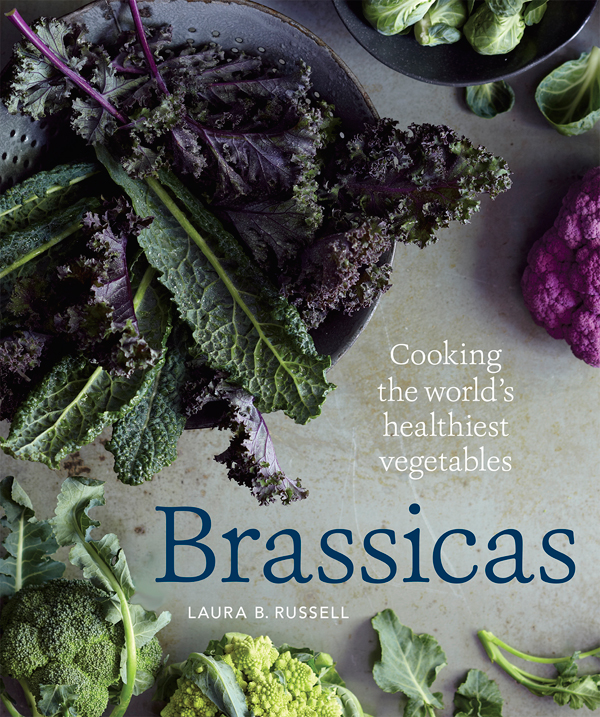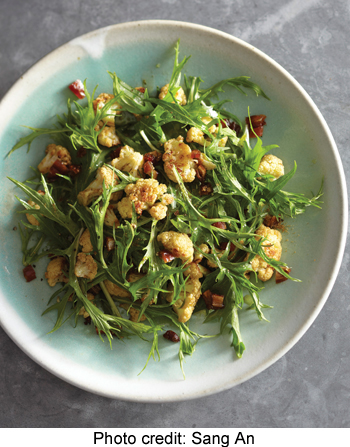The Oldways family needs no convincing that brassicas are delicious, but with recipes like cauliflower hummus, curried collards, and tantalizing turnip and apple salsa, Laura B. Russell’s book, Brassicas, took our admiration to a whole new level!
Divided into seven chapters as well as Brassica Basics that offer helpful tips on selection, prep, and nutrition, this book gives everyone the confidence they need to get cooking. In fact there are 80 amazing recipes that showcase the versatility of this very special group of vegetables. Some are more common, others harder to nd, but all offer home cooks a wonderful way to feed themselves and their families this nourishing and delicious group of vegetables. Lucky for us, Laura took the time to talk with us about her latest book and today we can share that conversation with all of you.
OLDWAYS: Can you tell us how your love affair with brassicas began
LBR: I love most vegetables, but I’ve always been specifically drawn to those with bold flavors broccoli rabe, watercress, and turnips, for example. Many people avoid foods with stronger flavors, but I think they have the ability to add excitement to your plate when handled properly.
OLDWAYS: Brassicas had, and in many cases still have, a bad rap. Why do you think this began and how is your book addressing these beliefs and working to dispel them
LBR: Some of the big-name brassicas cauliflower, Brussels sprouts, and cabbage have a reputation for being strong flavored and stinky. I think this stems from a lifetime of overcooking. If you grew up eating mushy, watery vegetables, then of course you’ll have a negative impression of them. There are considerably better ways to prepare these vegetables than boiling. In Brassicas, I introduce cooking methods and flavor pairings that enhance the vegetables inherent sweetness rather than highlighting their less favorable traits.
OLDWAYS: Talk with us about the brassica flavor spectrum and the four categories. What are they and can you share some examples
LBR: There’s this notion that all brassicas are strong or bitter. In fact, the brassica vegetables represent a wide range of flavor profiles, many quite nuanced. I’ve divided them among four general categories.
- Mild: sweet, nutty, or grassy vegetables like bok choy, kohlrabi, napa cabbage, and even cauliflower.
- Stronger: those vegetables with earthy, minerally, or pleasantly bitter characteristics like broccoli, kale, collard greens, or Brussels sprouts. These are the vegetables you don’t want to overcook or their sulfurous traits will emerge.
- Peppery: arugula, cress, radishes, and turnips reveal a distinctive peppery, often spicy burst of flavor.
- Pungent: Mustard, horseradish, and wasabi can often be considered sinus clearing in the most pleasant way possible.
OLDWAYS: Over the past few years kale has become a food phenomenon what brassica do you hope is the next food hero
LBR: I adore kohlrabi. I hadnt used much of it before experimenting for Brassicas, but its my new favorite vegetable. It tastes mild and sweet, somewhat reminiscent of broccoli stalks with a faint peppery finish. It’s very juicy and crisp when raw, but also tastes great in a vegetable curry. The leaves are edible as well and taste very similar to collard greens.
OLDWAYS: Folks can feel intimidated when meeting new groups of vegetables. Can you talk with our readers about your general selection and storage advice to help get them feeling more comfortable
LBR: Sure! You should choose vegetables that look fresh and vibrant, avoiding any that are wilting or yellowing. Time and excess water are the enemies of good storage. When you unload your groceries, remove any rubber bands or twist ties from bunched greens to avoid quick rotting. For similar reasons, remove tight plastic packaging from cauliflower or broccoli, as it traps moisture. Most vegetables keep well in a loosely sealed plastic bag with a paper towel tucked inside to wick away extra moisture. I do go into specifics for the individual vegetables in each of Brassicas chapter introductions.
OLDWAYS: You talk in the book about friend of brassicas and some pantry staples that pair well with this group of veggies. Can you share your short list with our readers
LBR: You need only three things to make nearly any brassica taste delicious: olive oil, garlic, and salt. With these in hand you can turn out a quick sauté, a pan full of roasted vegetables, or if you add lemon juice and salad. Because brassicas are all members of the same botanical family, it makes sense that they share an affinity for certain pairings. Some of my other favorites are red pepper makes and cured pork (bacon, pancetta, prosciutto).
OLDWAYS: It is always difficult to pick a favorite but would you mind choosing one of your recipes to share with our readers
LBR: It is difficult! These recipes have become my go-to weeknight staples. I really love the Mizuna Salad with Cumin-Roasted Cauliflower. It combines two brassicas mizuna and cauliflower with dates and a North African-inspired cumin vinaigrette. Mizuna is another of my favorite vegetables, but the salad also works well with baby arugula.
Mizuna Salad with Cumin-Roasted Cauliflower
You get a double dose of brassicas in this North African inspired salad that calls for both mizuna and cauliflower. My husband loves mizuna, a mildly peppery salad green, so we tend to eat a ton of it when it shows up at the farmers market in early spring. If you cannot and it, baby arugula (another brassica) makes an ideal substitute. Don’t forget to add the dates; their honeyed sweetness creates a perfect balance of flavors with the cumin-laced cauliflower and greens. Find fresh dates in the produce section or dried chopped dates near the raisins. I like the taste of honey in the dressing, but for a vegan-friendly version, substitute agave nectar.
Serves 4
Ingredients:
1 small head cauliflower, cored and cut into bite-size forets (about 4 cups)
5 tablespoons olive oil (divided)
3 4 teaspoon kosher salt (divided)
1-3 4 teaspoons ground cumin (divided)
1 tablespoon freshly squeezed lemon juice
1 teaspoon honey
1 4 teaspoon freshly ground black pepper
1 large bunch mizuna, large stems removed, or 1 (5-ounce) package baby arugula (about 12 cups loosely packed)
4 fresh or dried dates, pitted and finely chopped (about 1,2 cup)
Directions:
Preheat the oven to 450°F. Put the cauliflower on a rimmed baking sheet, drizzle with 2 tablespoons of the oil, sprinkle with ½ teaspoon of the salt and 1-½ teaspoons of the cumin, and toss to coat evenly, then spread in a single layer. Roast the cauliflower, stirring once or twice, for about 15 minutes, until golden brown and tender but not mushy. Taste a foret for doneness; larger forets may take slightly longer to cook.
While the cauliflower is roasting, make the dressing: In a small bowl, whisk together the lemon juice, honey, the remaining ¼ teaspoon salt and ¼ teaspoon cumin, and the pepper. Whisk in the remaining 3 tablespoons olive oil.
In a serving bowl, combine the roasted cauliflower, mizuna, and dates, drizzle with the dressing, and toss to coat evenly. Taste and add additional salt and pepper if needed. Serve immediately.
Reprinted with permission from Brassicas by Laura B. Russell (Ten Speed Press, © 2014).









Leave a comment